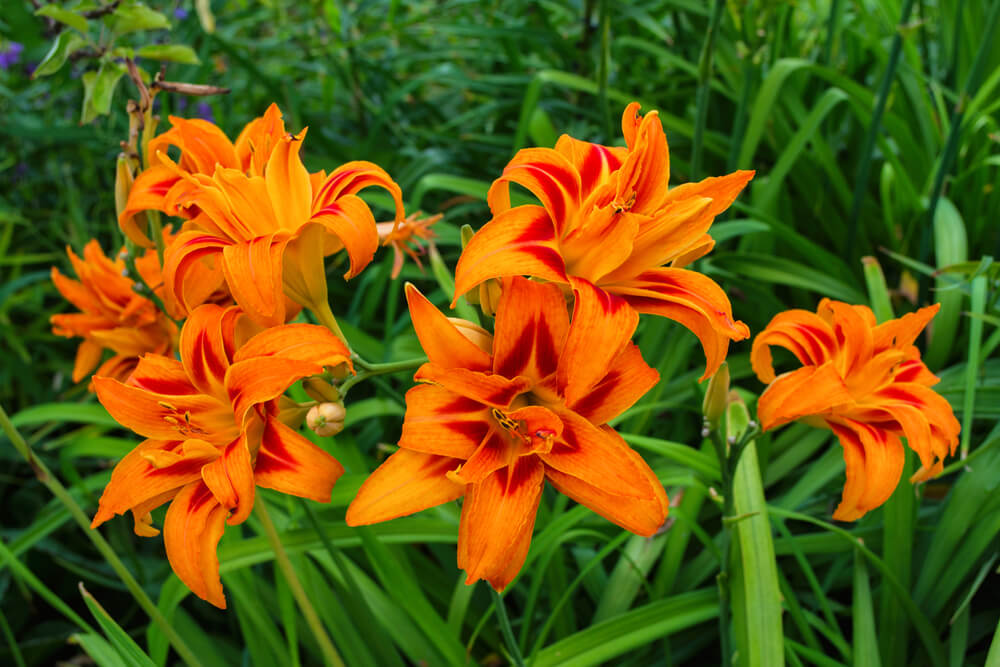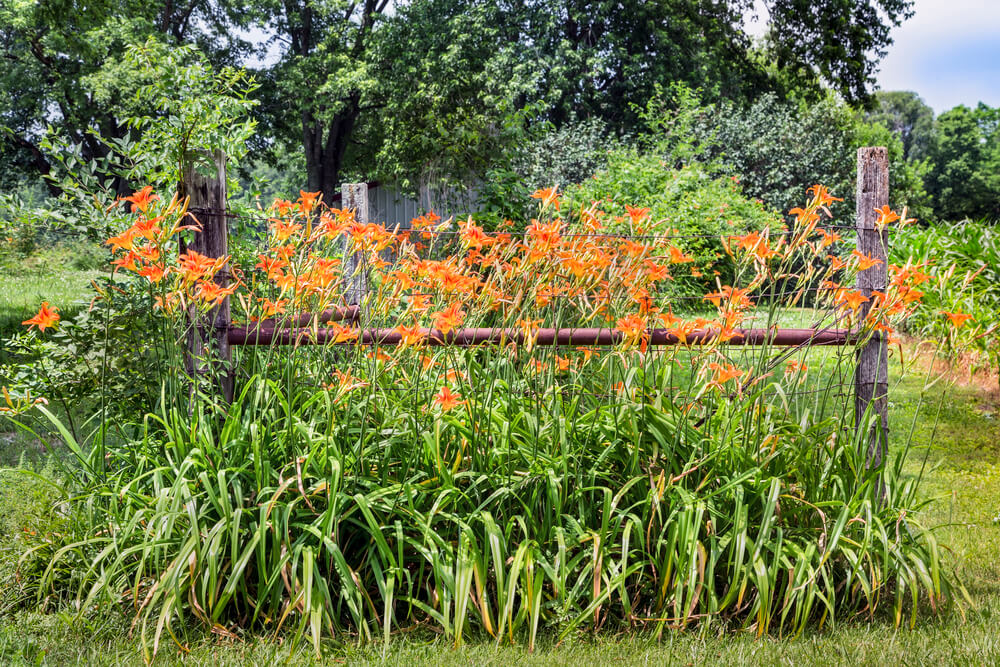Two Greek words, hemera, and kallos, combine into “day beauty” for Daylily’s designation. It is perfect. With exuberance, they greet the morning and die before the next day, making them all the more precious to gardeners. This guide will teach you everything you need to know about orange daylily care.
What is orange daylily?
The orange daylily (Hemerocallis fulva) enjoys partial shade and well-drained soil, much like the rest of the daylily family. Beginner gardeners will rejoice in the easy naturalization of these flowers. And, it won’t be time before the daylily produces rhizomes you can divide for propagation.
You can’t miss the orange daylily in the garden with its 5-inch diameter flower. That blossom tops a scape of up to 6 feet tall. There is nothing bashful about these blooms.
One excellent use for the orange daylily is as part of a perennial border. Pollinators love them, including butterflies. In some areas, the roots of this plant may help with erosion. Better still, they naturally crowd out weeds.
Toxicity to Felines: Daylilies make a dramatic addition to a vase, but avoid them if you have a cat. The entire plant, from top to bottom, is dangerous for cats. Just a nibble from a petal or drinking some of the vase water can lead to fatal kidney failure. Signs that your kitty may have gotten hold of a daylily include dramatically decreased activity levels, vomiting, and drooling. These symptoms can begin immediately or within 12 hours after ingestion. After 12 hours, damage begins. So if you suspect daylily poisoning, get your kitty to the vet post haste.
Key Takeaways
- Daylilies are adaptable and durable. They require little maintenance, making them perfect for beginners.
- Each blossom lasts but one day (so grow lots of them!).
- Some daylilies are evergreen, and others may re-bloom over the summer.
- Daylilies are among the most highly recommended flowers for home landscaping.
How to Grow Orange Daylily and Make it Thrive
Types of Daylilies
If you love orange daylilies but hoped for some variety, you have no worries. There are approximately 80,000 varieties of daylily. Here are a few for your consideration.
- Grass-leaf daylily: This is a dwarf plant with golden flowers. When they bloom, the garden erupts with a lovely smell. They bloom in spring and continue up to early summer.
- Happy Returns: As the name implies, this is a daylily that gives you more creamy yellow flowers throughout the season. They grow to 18 inches in both height and width.
- Red Volunteer: Bright cherry red petals melt into a yellow center. It’s impossible to hold back a smile when you see them. 30 inches tall; 7-inch blossoms.
- Rosy Scenario: As you might expect, this daylily has dark pink petals. Along the edges, you’ll see a white frill. The plant’s lime green center makes everything jump.
- Startle Daylily: You ready to be startled? This daylily is sure to please with red petals fringed in yellow. They grow 26 inches tall, crowned with their blossoms.
- Stella d’Oro: Possibly the world’s most recognizable daylily. These plants re-bloom throughout the growing season with bright-yellow flowers. This daylily grows one foot tall. It is an American Horticultural Society award winner.
- Wayside King Royale: If you love purple, you’re in for a treat. This daylily blooms early to mid-season. It stands tall and regal (36”) with wine-colored flowers measuring 6 inches.
- Yasmine: You might say the Yasmin daylily is peachy keen, literally. Its petals have a pastel peach tone with a yellow center. Height-30 inches. Blossom-6 inches.
Most orange daylilies reach their prime around their third season. Nonetheless, resist the temptation to divide clumps until after 5 years. Disturbing them can create root shock.
When to plant Orange Daylilies
Daylilies have a reputation for having a lot of brawn. You can put it into the soil in spring, summer, or fall (but if you ask them, they say spring). If you choose late spring or early fall, make sure to mix the soil with mulch.
Diversified Daylily Petals: The shape of daylily petals varies with the cultivar. Some seem like they’re ruffled and dressed for the ball. Some have musical profiles, like bells and trumpets. You can find daylilies with backward-bending petals and others that overlap each other. The orange daylily has 3 sepals and petals, which are of the cup or bell variety.

How to plant
Peek at the underside of your daylily. You need a hole twice as wide as the plant’s root system. Depth should be the same as the roots. Make sure the crown of the plant is above the soil line, not buried. Push firmly on the soil. Give them a good watering. Add mulch periodically to retain soil moisture.
Orange Daylily in Disguise: This flower’s name is deceptive. A daylily isn’t a true lily because they grow from fleshy roots. By comparison, a real lily grows from bulbs. Daylilies are from the genus Hemerocallis while proper lilies are of the genus Lilium.
Care & Keeping of Orange Daylilies
Daylilies require at least 6 hours of direct sunlight daily. If you live in a very hot region, plant them in a region of your yard that gets a little shade. Too much shade and your plants won’t bloom.
Daylilies benefit from nutrient-rich soil, so apply a slow-release fertilizer with low nitrogen. If you have potting soil on hand, mix it into the top six inches of native loam. Dust the surface around your plants with organic material. It deters weeds and conserves moisture.
Daylilies require one inch of water weekly. If you get more rain, decrease your watering regimen. Conversely, add more water during spans of soaring temperatures.
If you’re not already removing spent blooms from your orange daylilies, start. You want your plants to direct energy into new blossoms, not seeds. Also, get rid of faded or brown foliage.
Wintering
As a hardy perennial, daylilies won’t need much of your attention in winter. The plant naturally dies back to the ground at season’s end. When the first frost comes, remove dead foliage and flowers. Trim the flower’s stems to within 3 inches above the ground. If you suspect a harsh winter, top them with mulch.
Award Winning Flowers: The American Hemerocallis Society awarded several prizes to daylilies as being excellent choices for landscaping and the garden.

Common Orange Daylily Problem
Like other daylilies, this flower doesn’t like wet soil. Besides this, it’s worth the time to have your soil tested so you can get the right fertilizer for the spring.
If you plant your daylilies too deeply, it results in limited flowering and plant weakening. Dry, hot weather can impact your orange daylilies with leaf scorch. While it doesn’t look pleasant, the damage is superficial. You’ll notice tan areas on the leaves.
A Pound of Prevention
There are some simple things you can do to keep your orange daylilies healthy.
- Crowding: When you put your plant into the soil, give them room. They need good air circulation.
- Remove leaves showing leaf burn in order to stimulate recent growth.
- Supply sufficient water, particularly during long hot spells.
Daylily Erosion Control: Daylilies aren’t just ground cover and weed deterrents, the dense root web helps keep soil in place, even on steep slopes. Any type of daylily will work to stabilize soil, including the orange daylily.
Daylily Symbolism
Orange lilies, sometimes called Tiger Lily, are popular in Japan. It represents prosperity, power, and success. You will find them here in decorative bundles where people are celebrating things like a promotion. An alternative application is as a housewarming gift.
In the Victorian Language of Flowers, Daylily symbolized someone who knew how to tease. The flower suggests flirtation and precociousness. For example, if you wanted to show someone you have feelings for them, present that person with a daylily. Always keep one handy for your romancing tool kit.
The Chinese connect daylily with forgetting one’s worries. There is also a superstition that pregnant women who wear daylily in their hair daily will have a baby boy.

Color Coded Daylilies
The Orange daylily has positive and negative connotations. Depending on the setting, it reflects desire and passion. In others, it’s an emblem of ire. Yellow flowers represent happiness, friendship, and energy.
Purple daylilies portray mystery, inventiveness, grace, and authority. Red daylilies convey passion and love. The white petals on this flower are for honesty and innocence.
Greek stories tell of Hercules’ birth. While he was part human, Zeus wanted his son to have great powers. He brought Hercules to Hera and fed him her milk as she lay sleeping. When Hera woke, she removed Hercules, and two drops of her milk dripped out. One became the Milky Way, and the other fell to earth, giving life to the first lily.
Daylily Details: Growing Guide
One must treasure the orange daylily, enjoying the beauty of the bloom but for one day. In those moments, the flower shines bright. Bees and butterflies find the blossom attractive, making for amazing viewing. You will find growing and caring for orange daylily very fulfilling.
Frequently Asked Questions About Orange Daylily Care
Where do daylilies grow best?
You’ll often see daylilies gathering like schoolchildren waiting for the bus on the roadside. This space affords them plenty of sunlight. They need six or more hours of sunlight daily. Keep your plant warm and in well-drained soil, and it will thrive.
Are daylilies easy to maintain?
Daylilies are low maintenance. These easily grown perennials are tough and seem to survive in areas without any assistance. It’s a good plant for beginner gardeners.
What to do with daylilies after they bloom?
Remove spent blooms and any adjacent yellow leaves. Give them a slight pinch where the flower blossomed. It will help promote new growth.
Should you cut down daylilies after they bloom?
You can cut down daylilies in fall or early spring. Leave the plants alone in summer. Cuttings keep the orange daylily healthy. You don’t have to fuss much. Generally, just keep them clean and let nature do the rest.
Should daylilies be cut back for winter?
In late autumn and early winter, cutting back benefits daylilies. Get rid of dying leaves. Give them a gentle pruning.



